HOT TOPIC – Osmose: Game-changer or eMPEror’s new clothes?
The Expressive E Osmose keyboard is creating a real buzz in the industry right now. Is it that rarest of things, a genuine “game changer” or is it destined to be another footnote in music tech history? In the first of our HOT TOPIC features, we asked our synth experts for their opinions.
ED – Right, then this Osmose thing. You two can’t stop talking about it, so it’s time we threw it into the debating ring! In the “Pro” corner, we have Rob Puricelli. Rob believes that Osmose could be a breakthrough in expressive playing. In the “Against” corner, we have Robin Vincent, who questions whether it really matters.
I want a good clean fight lads, with no mucking about…
Osmose: the debate
Robin Vincent: The Osmose is the latest in a long line of technologies designed to give the electronic keyboard player a deeper sense of expression. It’s like there’s something deep inside those fingers that needs to come out that current instruments cannot accommodate. Is it driven by envy of other musicians who emote through strings, pipes and physical space? Or is it because they must be able to capture the exact nuance of a Bedouin Oud in their latest soundtrack? It feels like the Osmose is beautifully overcompensating for something. So much music has been expressed through keyboards, with a lightness of touch, the flick of a mod wheel and 128 levels of velocity. What is it that we feel is absent that the Osmose can provide?
Rob Puricelli: For decades, synth players have sought to achieve the levels of expression inherently found in other instruments, such as guitars, brass, strings and woodwind. The ability to add delicate nuance to their sounds has been limited to velocity, aftertouch, pitch bend and modulation. Some instruments packed in a ribbon controller too, but even with all of these, the humble keyboard player was bereft of ways to emote via delicate, natural, human movements. But with the dawn of MIDI 2.0 and MPE, some manufacturers saw an opportunity to right this wrong, and none have stirred so many as Expressive E and their long-awaited Osmose, a keyboard that delivers nuanced expression coupled with a powerful synthesis engine.
Do we need more expression?
RV: Do you really feel that the work of, say, Jan Hammer, Herbie Hancock, or Stevie Wonder somehow lacks emotional expression?
RP: Absolutely not, but then they were all looking for greater ways to express themselves. For example, Jan Hammer, beyond his days with the Mahavishnu Orchestra, was best known for squeezing out that legendary guitar sound made most famous in the Miami Vice theme. Herbie lauded the DX7 when it launched for the expression he got out of it with velocity and aftertouch. Stevie, more recently, has been a huge proponent of the Harpejji, which affords him guitar levels of expression but with a more keyboard-esque interface.
Would you say that there’s no place for enhanced expression being made available for keyboard players?
Can you have “too much” expression?
RV: No, but I am suggesting that expression already exists in their music. There’s a point of diminishing returns where all this technology isn’t going to add much to what the performance already contains through current means.
RP: But surely that implies that there is a threshold for means of expression? I don’t believe that is necessarily true. I think the Osmose delivers a number of deeply explorable avenues. Not least is the fact that a player can now play expressively with both hands without the need to use one hand for the pitch bend/mod wheel or ribbon. It seems to deliver not just new ways of expression but better ways of implementing existing expression. For example, how many of us wiggle our finger left and right when playing a lead sound, even though we know we would have to use a mod wheel to deliver that vibrato? The Osmose brings that back to the table many years after we saw it in the like of the GX1 or Ondes Martenot.
RV: I think there is a threshold. Maybe not on expression itself, but on our ability to capture and appreciate it. We are talking about electronics rather than organic resonators and vibrations. It’s like where you can have limitless sample rates, but there’s a point where we fail to notice the increased resolution.
We’ve had this sort of expression in the ROLI Seaboard and other MPE controllers, and I get the feeling these end up gathering dust in forgotten corners of the studio. Why would the Osmose be any different once we’re past the “oooo this is nice” feature?
A new synth is born?
RP: I think the Osmose goes beyond things like the Rise and other controllers because it is a standalone synth. I know that the Rise comes with some software synths that have been designed for it, but I think the Osmose will deliver a far more satisfying experience because it is intrinsically connected to the synth engine.
Some of the demos I’ve seen seem to deliver a far more accessible degree of expression. Also, unlike the squidgy Rise surface, you can approach it as a traditional piano/synth-type action and then begin to go deeper.
True, it may end up gathering dust and be a short-lived fad… time will tell, but I really do think that the standalone nature of the unit and a very competitive price point will see it taken up in bigger numbers than its competitors.
You are currently viewing a placeholder content from YouTube. To access the actual content, click the button below. Please note that doing so will share data with third-party providers.
RV: The connection to the Haken Audio EaganMatrix is certainly an interesting one. The standalone nature of it will broaden its appeal. Although to get into the guts of it, you’ll still have to treat it as a software synth.
Where do you see it finding its place in the studio? Or do you think it’s more of a live-performance device?
RP: I think it can serve both purposes really well. You know when you see a Spitfire Audio library demo and they have those Monogram CC controllers to handle expression? Well, Osmose would allow you to free up that left hand, so for laying down orchestral tracks, I think Osmose could be a real boon. As for live use, Osmose would probably lend itself more to jazz players than conventional keys players in pop/rock bands. Although bands like Muse might lap this right up!
Will OSMOSE integrate?
RP: Do you think we will end up hearing Osmose sounds and more expressive keyboard parts in the coming months and years or not? Given your experience in the world of Eurorack, could you see it breaking new ground there?
RV: No, not in the slightest. I’ve always expected that we would hear sliding chords and polyphonic expression all over the place with MPE. And really, if it is there, I don’t think anyone has noticed. It’s a technology that is fun to play with but is largely lost in the process of building tracks or writing music.
Eurorack barely has velocity. The idea that you would patch in multiple levels of manually operated modulation is, in my view, exhausting! I’ve tried MPE controller rings, light beams and touch plates, and it makes my arms ache just thinking about it. The expression is already there through the curves and possibilities of LFOs, time, voltage manipulation and interfacing with signals. Adding an Osmose would turn your lovingly crafted machine of mystery into just another synthesizer.
What Osmose signals to me is another nail in the coffin of the career of the instrument player. Coming from the insatiable desire of the keyboard player to sound like everybody else. In expanding the reach of the keys, we narrow the scope and possibility of other musicians. But at the moment the Osmose still requires talent to extract a convincing performance. How long until we get the Osmose equivalent of 20 quid MIDI Packs to do all the expression for you? I know it’s a cliche, and every new technology gets “concerned individuals” shouting about how it’s the end of everything, but maybe this is the tipping point.
Will Osmose replace musicians?
RP: It’s interesting to hear your argument about it putting people out of work. I remember when the Musician’s Union here in the U.K. became most vocal on the subject of Fairlight’s putting real musicians out of work. Now, it seems, sample library developers pay out millions in royalties to orchestras, and everyone seems happy!
But I do take your point. I don’t necessarily think that Osmose players will be looking to usurp string sections and the like. But given the hugely impressive sound engine, we may see some interesting and unique synth performances. And that’s another reason I believe that the Osmose is a force for good. It will allow keyboard players to be even more uniquely and individually expressive than ever before.
RV: So, did Peter Gabriel’s Sledgehammer result in more Shakuhachi players finding work? I don’t know; it’s an interesting train of thought that won’t actually do anything to hold back the march of western musical colonial and appropriational progress (if that’s a thing).
Many years ago, I built a GigaStudio system for David Arnold. And “technology putting musicians out of work” had become a hot topic (again). We talked about it a lot in reference to his work. He said that the GigaStudio system enabled him to employ more musicians and use more orchestras because he didn’t have to rely on the imagination of the producers to understand what an orchestra could contribute.
RP: It’s a good point, and I can see the Osmose allowing people like David to fully and accurately mock up certain parts to appease producers. But, invariably, the end product is played by a human on the real deal, so everyone’s a winner.
I just think the Osmose, rather than looking to usurp other “real” musicians from their day jobs, simply affords keyboard players the levels of expression others have enjoyed for many centuries. I also think that, more than any other MPE-based controller, it WILL inspire new music where its use is more obvious and noticeable.
You are currently viewing a placeholder content from YouTube. To access the actual content, click the button below. Please note that doing so will share data with third-party providers.
The final replacement for “live” musicians?
RV: I think my point is that it’s not “invariably“; there’s less and less a reason to employ a real musician. It’s like a producer walks into a room of musicians and asks if anyone can play flute – “I can” says the keyboard player.
“Ok, what about a Chinese Moon guitar?”
“Oh, me, I can” says the same keyboardist.
“And I’ll need some strings”
“I’ve got you covered”
Etc etc, on and on, until everyone rises up and murders the rude-arse keyboard player. There seems to be this sense of entitlement that keyboard players must have access to the same level of expression as everyone else. But not in order to make a piano sound better, but so they can mimic and take the artistry away from every other musician who has worked on their instrument. It’s, I don’t know, a bit rude?
RP: Haha! Too funny! I really don’t see it in such an adversarial way. No producer is going to ask a keyboard player to do the flute part if there’s a flautist in the room. But for the upcoming synth duo who want a small flute melody and want it to sound authentic, they may defer to the Osmose. But again, I see Osmose as opening up expression in synthesis, not in plagiarising pre-existing instruments. The same went for sampling, all those years ago, and you and I are both old enough to remember that. Yet, here we are, and no line of instruments has been made redundant.
And anyway, guitarists, violinists, sax players, flautists and more have all taken steps into the world of synthesis. They’ve added OUR unique capabilities to their instruments, e.g. Akai’s EWI, Yamaha’s WX, Roland’s GR Series. And as a drummer, there are a myriad options in the world of synthesized and sampled beats. I really don’t subscribe to the idea that keyboard players are moving out of their lane, so to speak.
Will Osmose change the way we hear music?
RV: I think the crux of the matter is whether Osmose will contribute to music in a meaningful way. Very few things are actual game-changers. In my view, MPE has been more of an interesting curiosity than something that’s impacted the industry. Maybe this will, or maybe the point is that we’re not supposed to notice.
Do you think it will sell beyond the eager enthusiast?
RP: Well, I had no real interest in the ROLI Seaboard Rise but the Osmose really excites me. I think that is down to two things; A built-in synth engine and traditional keys. The Rise had neither and that, for me, consigned it to the eager enthusiast brigade.
Will Osmose be a proverbial “game-changer”? Probably not. I can’t see the traditional keyboard mechanism being replaced anytime soon in favour of their technology. Will it complement a player’s existing live or recording rig? Absolutely. But it will require the likes of MIDI 2.0 and MPE to settle down and bed in before we see any form of wider adoption. However, top marks to Expressive E for producing something new, different and thought-provoking!
RV: Well, we’ll both be able to try it out at the forthcoming Synth East in March.
ED: So there you have it, two titans of synth opinions have battled it out and made excellent arguments both for and against the Osmose. What are your opinions? Have you got one on order? Do you think it’s a genuine “game changer” or is it just another fad we’ll have forgotten about in six months?

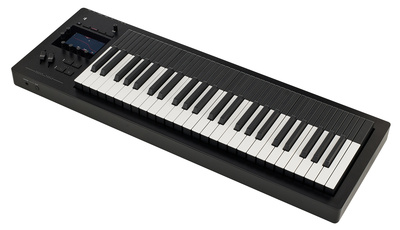
30 responses to “HOT TOPIC – Osmose: Game-changer or eMPEror’s new clothes?”


 3,9 / 5,0 |
3,9 / 5,0 | 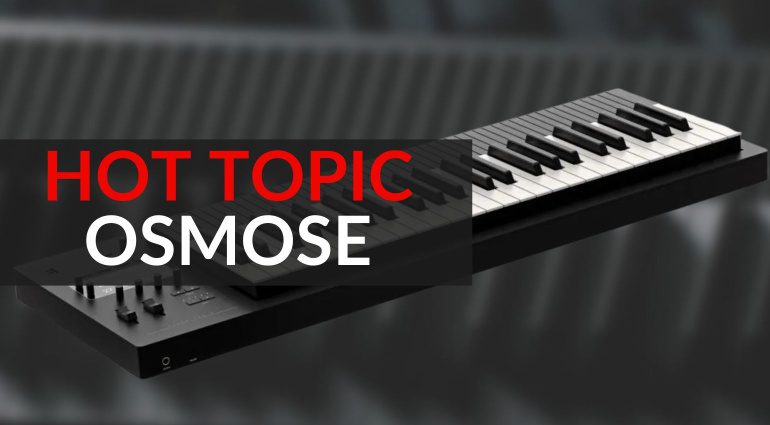

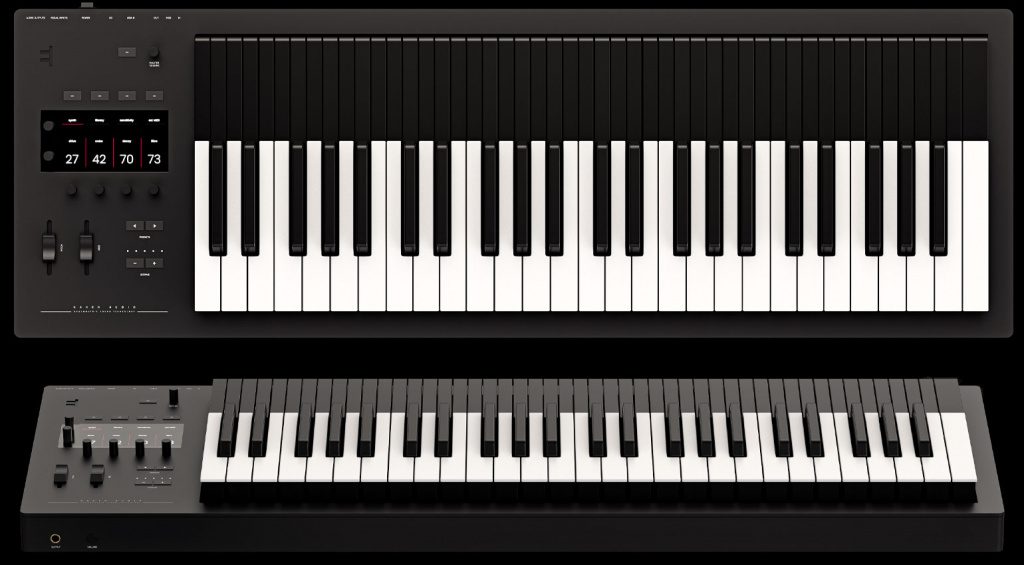

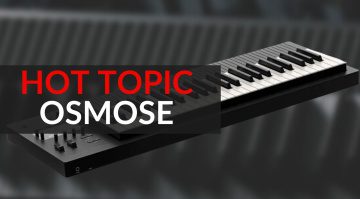

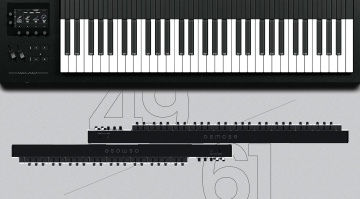
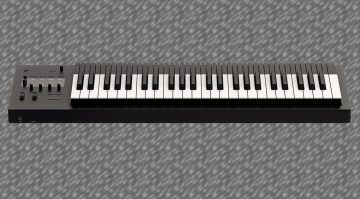
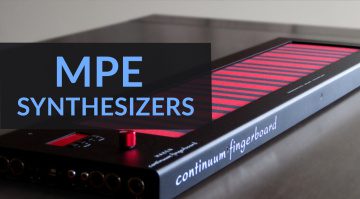
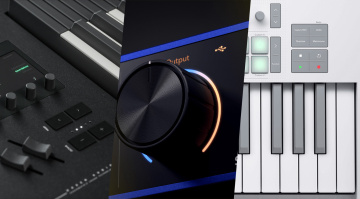
I’m far too much of a longstanding expressive controller, MPE and now Osmose enthusiast to think that I am well placed to predict without excessive bias how much this stuff will catch on and stand the test of time. But I certainly dont find arguments that boil down to cries of ‘gimmick’ and ‘stay in your lane’ remotely compelling.
I believe that Roger Linns motivation with the Linnstrument involved a deep desire to see more of a return to ‘virtuoso’ performances. It is unclear to what extent this will actually happen in certain mainstream realms due to longstanding trends in pop music and the world of entertainment that goes with that. I’ll be happy enough if expressive controllers for electronic music at least manage to find a home in a meaningful niche and a bit more visibility here and there. IF they inspire some people to practice, play and perform then its all good. And the number of synths that support MPE has swelled nicely in recent years.
“And the number of synths that support MPE has swelled nicely in recent years.”
^ Part of me wonders if it’s a kind of adoption S-curve.
The piano was slow to catch on at first, too. Apparently, most people were loathe to give up their harpsichords for this newfangled “velocity sensitivity”, and they were just too expensive. Also, there’s the matter of people decrying it as being too difficult to learn and adapt to. Thanks to the innovations of Johann Zumpe — a Roger Linn of his time — Bach helped promote the kit and get the word out.
Sounds familiar…
I have an Osmose (and a Linnstrument, an Eigenharp Alpha, and a Claravox).
For me, the question centres on the playing experience and personal music. In that context these instruments are exceptional and connect the players motor-sensory system to their music in a way that other instruments can’t. I suppose some modwigglers might argue for knob tweaking?
Does that matter to commercial music? Well, these things can contribute some things that others can’t, but there seems to be vanishingly little commercial music that requires unique nuance (or player experience).
@Robin Vincent Can you please elaborate on why you feel this is?
“… I get the feeling these end up gathering dust in forgotten corners of the studio.”
If a keyboard player is already naturally making certain gestures but they weren’t captured by previous hardware, yet the Osmose is making use of that additional info without imposing a headache to capture that energy — isn’t this really about fidelity, not novelty?
Cost, education, and accessibility/familiarity are some historical barriers to MPE adoption.
I’ve had my own fair share of “expressive devices” that were a headache to configure, and the friction of THAT terrible usability led to them being sold. Another point: Ableton Live before proper MPE support was a real annoying kludge to work with, but now is heaps better. Total integration is essential.
I think there’s a big difference between what a keyboard player THINKS he is adding using gestural stuff that isn’t detected, and what ACTUALLY comes out once he plays a keyboard that actually does detect it!
We’re all convinced that what we are doing would sound amazing if it was picked up, but the truth is, listen to most Roli demos and it’s seldom very good. Our imagination is filling in the blanks, but the reality is seldom as pretty!
Record yourself playing a keyboard with the sound off. You might THINK you nailed it, but playback is seldom that good. Same with finger gestural stuff. The reality seldom matches the promise…
No, “Record yourself playing…” hasn’t been my experience. I don’t think the “seldom” is a useful generalization, either, based on what I’ve heard on ROLI and others — and the new Osmose videos from various performers have made me smile a lot.
A closer comparison would be taking a photo with a much higher resolution camera, then becoming aware of details that weren’t present before, so there is a learning and adjustment period to adapt to take advantage of what’s new. Now, I’d characterize that as fair. In the case of an MPE instrument and such though, you could disable/strip out certain dimensions when not needed for those particular performance contexts, but the opposite on a non-MPE instrument isn’t true.
You’re trying to tell me you actually recorded yourself with the sound off? Really???
Look, if keyboard players achieved what they hear in their heads when they actually got to use a Roli, the web would be full of amazing music. The sad truth is, the gestural stuff is MUCH harder to achieve than our imagination would like.
It’s like playing the violin. Seems easy in theory. A string, a finger, a bow. But in practice, it takes decades to master and the first few years are excruciating! Multi-gestural MPE keyboards add so many extra dimensions of control that can affect your sound adversely as well as positively, as many as a violin. Controlling and mastering all that may take longer than most musicians are willing to spend.
> actually recorded yourself with the sound off
Yes, I have, in a variety of scenarios. I find this useful when examining performance bias on even “normal” keybeds (not MPE ones). Getting a sense of how the keys feel. Similar to sensitivity to QWERTY mechanical keyboards with different keyswitch types.
The first time I experienced aftertouch (without knowing what it was) on an Alesis QS8, I thought my mind was playing tricks on me.
> the gestural stuff is MUCH harder to achieve than our imagination would like.
See my comment elsewhere on this page about the Continuum and being a virtuoso. I think we agree about mastery.
However, I’d politely disagree your sweeping generalizations — you keep saying “our imagination” but that’s “your” experience and doesn’t speak for others. I also invite you to consider other diverse viewpoints and cultures: e.g., Carnatic music with its ornamentation naturally gravitates towards a lot of these pitch-warbling idioms. A.R. Rahman has already made a big positive difference with the Seaboard in his soundtracks and education, and this was some years ago: https://roli.com/stories/seaboardists-of-chennai
Speaking of, also very interesting what I’ve observed with children who start on an MPE instrument (even these “toylike” ones), as opposed to beginning on a conventional piano: without prior assumptions, they pick it up a lot more easily, like other tech. The adoption will take awhile — but doesn’t it always?
My overall point is: the Osmose doesn’t _need_ to be an instrument for _everyone_ — but it will help bridge the gap for those who are comfortable with the piano paradigm + more.
Also see my post that the piano took decades to catch on, too…
Because you rarely see them in use. I don’t see them in youtube videos, in producer hideouts, on live rigs or performances. And perhaps more importantly I don’t hear, or believe I hear, any super enhanced expressive playing that sounds any different to what we already hear. I don’t think you really need at £1600 keyboard to enable you to wobble a note a little bit when there’s a perfectly good mod wheel sitting right there.
The ability to apply various forms of modulation to certain notes you are playing and not others you are playing at the same time seems to be missing from the picture you paint when you start going on about mod wheels.
And synths like the Deckards Dream, just like the CS80 that inspired it, demonstrate pretty well what things like polyphonic aftertouch bring to the table. Not everyone or every style of music and playing is going to appreciate that, but its an undeniable part of what makes instruments like that great.
Yes, I really relate to this — at which point I have to declare to the “anti-MPE” camp: well, where do you draw the line? Channel aftertouch? Poly aftertouch?
@Robin Vincent did call out the “Haken Audio EaganMatrix” and I’d like to EMPHASIZE something meaningful about that: Lippold Haken and others have emphasized (for two decades now!) that with the Continuum Fingerboard, the expectation is that you NEED to put in the time to learn it as a new instrument, then you can learn what it’s capable of… maybe be a virtuoso.
But what’s different with the Osmose is that it updates the clunky EaganMatrix UI into something friendlier, and the expectation has changed, since this is now a discrete keybed that’s a lot more familiar to existing piano players.
> I don’t see them in youtube videos…
Robin, you do know YouTube videos are not the real world?
Ha, so not seeing is not believing? 🤣
Really appreciate your other post too, Richard.
And some of my fave MPE performers just do it in the privacy of their own studio, as they have deadlines to meet — they aren’t social media influencers so much as working professionals. Using it as a tool to get the job done, and maybe, just maybe having more expressive fun and wild pitchswooping whilst doing it.
Your point being that videos of people playing music in their studios are somehow imaginary?
Re: “mod wheel”, what do you think of the Expressive E Touché? Does it add any value for you as opposed to a regular mod wheel/joystick? It adds springy bounce which is very difficult to gesturally achieve on a typical mod wheel. I love it.
I think the Touche thing is great – it’s all great, all these things are fabulous. I’m not doubting the usefulness of the technology, I’m doubting how it will actually change anything or result in more expressive performances. The Touche lets you twang things in perhaps a more convenient way than getting the exact same result using multiple levels of velocity on a key.
Thanks for clarifying. That reminds me of a couple things:
(1) The Touche has enabled performers to get more life out of older sounds (like, say some 1980s ROMplers), because the original controllers available during a particular instrument’s era may not have been flexible enough. I view it as augmenting velocity-switching though, not substitute for it — another layer, or dimension as marketing-speak says. For me, it’s changed so much already.
(2) While anyone with enough patience could step-edit in CC etc. data to get the same result as a full-fledged MPE controller, the realtime nuance/subtlety is where these kinds of gadgets shine. As an anti-“gimmick”, they must actually be practical enough to be BORING on some level — as in, a tool becomes a part of your daily routine. It may still make you smile, but it’s conducive with your workflow. Related book I’d recommend: Atomic Habits. Not explicitly about music, but has a lot of thoughts about daily discipline and systems used to get that DONE.
Mod wheels tie up one hand (you CAN actually play with both, right?), and you still end up with a LFO doing vibrato, which is utterly different to how real musical instruments do it. Vibrato varies in speed and intensity and phase every time it is used in something like a cello or sax. An LFO is a poor imitation of something that is FAR more expressive in real life.
A touch strip allows for a far better way of imitating vibrato than a mod wheel. But still ties up one hand.
Better vibrato is, BTW, a prime use case the Expressive E Touche addresses — have you played one?
E.g., soloing with one hand while doing delicate (or vigorous) vibrato with the other. It responds to both feather-light touches and aggressive strikes in a more tactile manner than conventional mod wheels.
In doing so, rather than just tying up one hand for a singular gesture, you get up to 4 CCs at once, so it could be pitchbend on the sides + modwheel (001) + breath (002). Whether you’re drifting with a finger for elegant articulations or striking with a palm for those EDM wobbles. Really nice bit of kit, especially with the different wood grains that make it feel more like an acoustic instrument.
I’d like to hear your thoughts on Osmose vs Hydrasynth. Both very digital and expressive.
Because you’re basically my favourite music tech reviewer.
Thanks
I think there’s too much attention payed to adding expression to keyboard playing by use of the fingers alone. There are already extremely underused methods of controlling sounds like expression pedals, and particularly multi axis breath controllers like the TEC ones. But you see few using them.
If you listen to the vast majority of Roli demos, to be quite frank, the number of people you can call true masters is less than a handful. There’s a difficulty of playing the keys alone with accuracy and creativity, now you want to take a skill and exponentially expand the precision you need to extract all the nuance that other instruments take almost the entire body to inject expression into..!
I remember a few keyboards (some Yamaha home organs of the 70’s come to mind) that wobbling your fingers induced vibrato, that was awesome. However, the mechanisms for achieving that were delicate.
But pretty much what I’ve seen from Roli videos is people playing pretty damn slowly to give them time for the gestural stuff, which is a pretty poor trade off, imho..!
I think what we first need to do is find an expressive need that can’t ALREADY be filled with less expensive methods, especially ones that don’t interfere with normal playing.
Roli’s have been out for what, five years or so. And, to be candid, I have heard only one person (Marco Parisi) that I would consider has truly mastered it. That’s not exactly a ringing endorsement of how easy something is to master.
I’m all for allowing a keyboard to do the side to side vibrato rocking, but it seems an awfully expensive way to add one extra dimension of usable control.
For about $300, you can add a TEC breath controller with bite and tilt detection and gain three addition axes of expression that don’t interfere in the slightest with your keyboard technique.
I have played a bit of clarinet and have used a 1D breath contoller from TEC – already there I found it very natural to add expression – in principle you could use aftertouch – but on what “natural” instrument do ypu control/express by pressing with your finger? The wobbling motion is both closer to what you could do on a stringed instrument – and it is also more coherent with the sideways motion of hands and fingers as you play keys. Pressing on a key (or more as in polyaftertouch) interferes too much in anything but very slow/long playing/notes.
@Rasmus Now that’s an intriguing hot take — as have similar opinions I’ve heard from people whose primary instrument is a NON-keyboard one.
Re: “wobbling motion is both closer…” that’s what I’ve heard from people (and myself) using the Expressive E Touché, albeit on a per-channel level, since you can get subtle pitch and other drifting that is VERY difficult to achieve on a typical mod wheel.
@Diki Ross I admire the work TEC have done over the years, glad you brought them up! The tradeoff for some is that a breath controller has friction of wearing it on/off when you’re moving about. Similar thing re: gesture rings, gloves, etc. The nice thing about having “expression potential directly in the keys” is you aren’t going to get tangled in wires when you also have headphones on.
This is also true of musicians who have mobility issues or have had stress injuries which make it more difficult for them to reach for a separate control.
Osmose seems like a weird hybrid. It is the first real MPE keyboard. And it’s a super-expressive poly synth for under $2000.
Frankly, connecting an MPE controller like a Linstrument to an MPE synth is just easy at this point. Hundreds of synths now support the MPE protocol. And it really is a revolutionary improvement over a mod wheel and pitchwheel for players of all experience and skill levels.
Osmose is really the first controller that brings MPE to a real piano-style keyboard.
Roli Seaboard Rise is just a weird anomaly. It’s not a keyboard. It’s its own thing.
Perception is that an MPE controller has to have a standalone synth. And look at the success of the ASM Hydrasynth with its poly-aftertouch. It has allowed ASM to enter the synth market starting from zero.
Good callout that it’s not just a controller but a full-fledged instrument. I view it as a more mass-market (I hope) spiritual successor to the Haken Continuum in some respects.
I’d seen previous attempts with a “real piano-style keyboard” such as the TouchKeys, but even that was a controller add-on and not a totally integrated unit.
There are some gestures which are possible on Continuum and RISE which aren’t here, like traversing two fingers in opposite multi-octave directions. But, the Osmose feels like the closest implementation so far of bridging the familiarity gap.
Agreed re: Hydrasynth, they’ve had smart marketing too about being so strongly weighted in other areas, then treating the poly-aftertouch as a BIG bonus. Arturia took a similar approach with the MicroFreak, but lost that poly-ness on the MiniFreak.
Quite frankly manufacturing complications aside), it’s unintuitively bizarre how long it’s taken for even poly-aftertouch to gain acceptance.
I suppose like in other fields, you really have to do fight for your right to express yourself. 😉
I think I might find it attractive if they made a controller only version for well under $1k.
New Roli’s are through the roof.
Osmose is the first mechanical upgrade to the keyboard since the forte action. Many thought the Forte could never replace the Harpsichord at the time, not least, Bach. Till now, all keyboards are blunt axes for melody, compared to Violin, Saxophone, or Voice, wheels non-withstanding. It’s polyphony and autotune have make it useful. Though his keyboard tried, Stevie Wonder had to do the singing. Current EWI and MIDI strings are epically crude and do not leverage Sax and String skills as the Keyboard has in Electronic Music. Controller drought, essentially. The Osmose won’t be the MPE guitar with pressure sensitive fretboard etc, we should have had long ago, yet Osmose action, long overdue, is a huge upgrade: the reaction of player after player make that clear.
Very late to this party, but I thought I chime in since I have owned the Korg Prophecy, Expressive E, Linnstrument, Roly Seaboard, and now the Osmose. To be fair, I’m no keyboard hero whatsoever. That being said, I always dreamed of getting more expression in my music. I really like to have some string or flute sounds with all kinds of expressions. With the Linnstrument and Roli, I wasn’t getting the desired results. It felt like learning a new instrument (steep learning curve), and it didn’t feel good. I really disliked the rubbery feel of both. With the Osmose I finally feel like I can do the stuff I wanted for a very long time. It still isn’t the best performance ever, but it’s ten times better than the results I got with all the other stuff. I’m very happy, to say the least.
Cheers, Ronald.
I got a seaboard rise about 5 years ago. I love love it… I take it to jam sessions with some very good players and it is just silly wonderful to play. I don’t take a standard keyboard at all. I’d give up black and white keys to keep it. The Rise II is easier to play more standard keyboard parts on but less fluid to play than the original Rise. I pre-ordered an Osmose in 2019: looking forward! Strange note: I type with 3 fingers… somehow this technique transfers fantastically to the Seaboard. Conventional piano technique is not so useful on the Rise (more so on the Rise II).
Late to this party, but I’ve had my Osmose for exactly 4 days, and used it in exactly one jam session (the day after it arrived) and it is not hyperbole to say that it has already changed my entire way of thinking about an instrument/interface that I was classically trained on and have played for about 50 years. In our little jam session, my guitar player (an incredible musician) was absolutely gobsmacked when I pulled out a slide guitar/pedal steel type of patch with the pressure glide on and started wangling out very convincing interval slides with subtle vibrato. That’s not even mentioning the way string sections and other orchestral sounds can be both legato and sforzando at the same time. I’ve been reading that it was a “soundtrack” machine for months. Now I know why. I tried a Seaboard once and it was fun, but not very useful to a trained piano player. This is MORE than useful, it’s a whole new arsenal of expression that finally gives me access to the expressiveness string, wind, and even percussion players have enjoyed forever. Look out world!
You are currently viewing a placeholder content from Facebook. To access the actual content, click the button below. Please note that doing so will share data with third-party providers.
More InformationYou are currently viewing a placeholder content from Instagram. To access the actual content, click the button below. Please note that doing so will share data with third-party providers.
More InformationYou are currently viewing a placeholder content from X. To access the actual content, click the button below. Please note that doing so will share data with third-party providers.
More Information